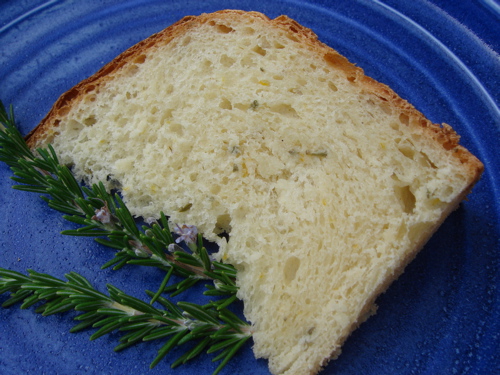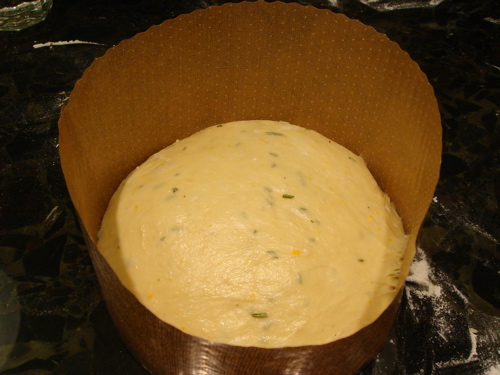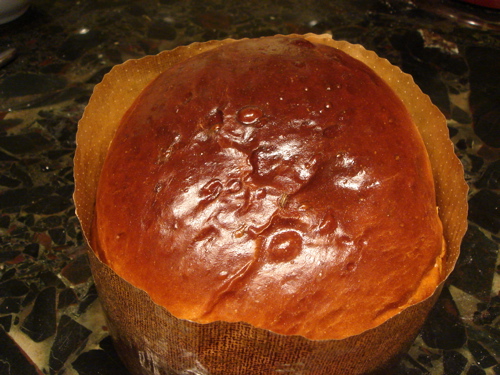How embarrassing.
The breadbakingday #01 challenge, as presented by Zorra, was to bake a bread with herbs. Yes, I thought, I can do this!
I have a beautiful couple of rosemary plants that have really taken off this year, but today I didn’t feel like doing my oft-made rosemary-olive sourdough. I had the brilliant idea that I would create something quite different from my usual fare, to present for my first blogging event.
 Let’s just say this was not my finest example of clear thinking. But my thought when I started this blog was to document the bloopers as well as the unqualified successes, and in the end this didn’t turn out too bad anyway.
Let’s just say this was not my finest example of clear thinking. But my thought when I started this blog was to document the bloopers as well as the unqualified successes, and in the end this didn’t turn out too bad anyway.
My idea was to take a recipe for sweet egg bread, which I have made a few times but not often, add some chopped rosemary and orange zest, and form it into spiral rolls that would be lovely for breakfast. I have braided this bread in the past, and the dough has been firm enough to do so easily.
 Well. Whether because I mis-scaled something, or I mixed the dough improperly, or the rosemary and orange zest had a super-relaxing effect, I’m not sure. All I can say is that it became apparent early on that all was not according to plan, and it got worse before it got better.
Well. Whether because I mis-scaled something, or I mixed the dough improperly, or the rosemary and orange zest had a super-relaxing effect, I’m not sure. All I can say is that it became apparent early on that all was not according to plan, and it got worse before it got better.
I present the steps I followed, not exactly as a recipe, but as a chronicle of the comedy of errors that was my morning:
Ingredients for pâte fermentée:
- 214 g flour
146 g water
1 g instant yeast (1/3 teaspoon)
4.5 g salt (3/4 teaspoon)
Ingredients for final dough:
- 365 g flour
161 g water at about 65F
3 g instant yeast (1 teaspoon)
7.5 g salt (1-1/4 teaspoons)
all of the pâte fermentée
73 g eggs (about 1/3 cup, or 1.5 large eggs; start with 2 eggs, measure what’s needed, and save the rest for glazing the dough)
18 g milk powder
5 g finely chopped rosemary (2 teaspoons)
6 g finely grated orange zest (2 teaspoons; about one medium orange)
73 g sugar
54 g butter, softened
Method:
- The night before baking, knead pâte fermentée ingredients together lightly by hand until a soft, sticky but smooth dough forms. Place the dough in a bowl covered with plastic wrap, rest at room temperature for one hour, then refrigerate overnight.
- The next morning, take the pâte fermentee out and cut it into about 16 pieces. Let it rest at room temperature for 30 minutes.
- Now mix the final dough. Combine flour, about 80% of the water, yeast, salt, eggs, milk powder, rosemary, and orange zest in the bowl of a stand mixer fitted with a dough hook. Mix in low speed to just combine.
- See that the dough seems dry at this point, and forget that you’ve still got butter and pâte fermentée to add, so go ahead and add all of the rest of the water. [Alternative, recommended step if you’re after a stiffish, shape-able dough: reserve some water for a little later, when you get a better idea of the dough consistency, and add it only if it’s needed.]
- Add the pâte fermentée chunks and continue to mix in low speed for a minute or two, until they are incorporated into the dough.
- Turn the mixer to medium speed and add the sugar in increments until just incorporated. [Alternative, recommended step: continue to mix in second speed until gluten is moderately well-developed before proceeding to Step 7.]
- Add the butter in pieces, and continue mixing in medium speed for another minute or two.
- Realize that this dough is much slacker than what you wanted, and start to
panicbe concerned. Refuse to add flour to firm it up, because this goes against every fiber of your being, believing as you do that adjusting the water is the only proper way to control dough consistency. Stubbornly refuse to be flexible on this. Begin to understand that this dough is destined for some kind of a pan or form. - Continue mixing in second speed until the dough develops a moderate amount of elasticity and starts to pull away from the sides of the bowl, although it is still very soft. You can sort of stretch a handful of the dough to some semblance of a wet windowpane.
- Because this dough bears a resemblance to panettone more closely than to any other dough you’ve made, think of the paper panettone molds left over from last Christmas that you’ve got stashed away somewhere. Search and discover that you have two of the 5″ forms, which should be just perfect for this amount of dough.
- Divide (scoop/plop) the dough between the two molds. Realize that you have completely forgotten to let the dough have a first fermentation. In the process of transferring the dough from the molds to a lightly oiled container for said fermentation, rip and completely destroy the molds. [Alternative, recommended step: I don’t think I have to spell this out.]
- Let the dough ferment for 1 hour and 30 minutes, until almost double.
- Turn the dough out onto a lightly floured counter and knead lightly a few times with floured hands to get a reasonably smooth-surfaced blob. This is challenging because the dough is very wet.
- Use a dough cutter to help simultaneously push the edges of the blob underneath while turning it around in a circle, to form a fairly even mound of dough. Because you ruined your only remaining 5″ molds, you will now have to use a single 7″ mold, so do not divide the dough in half.

- Again using the dough cutter to help, pick up and plop the dough into the mold while trying, only marginally successfully, to maintain the smooth surface.
- Proof for 1 hour and 15 minutes, until the dough has approximately doubled in volume.
- While the dough is proofing, preheat the oven to 360F.
- Prior to baking, brush the top of the dough with the reserved egg.
- Place the bread in the oven and turn the heat to 350F. Bake for 30 minutes.
- Remove the bread from the oven to check for doneness by taking its temperature. The top looks nice and brown, but is lopsided, probably from being too high up in the oven chamber. You cannot get the instant-read thermometer into the bottom of the loaf (through the mold) without turning the bread onto its side, so you do this and create a nice flat side on the loaf. Realize that the loaf is nowhere near fully baked when the thermometer registers 139F.
- Turn the heat down to 335 and return the bread to the oven for another 15 minutes.
- When you take its temperature the second time, reinforce that flat side, just for good measure. This time it registers 205F — done.
- Cool the loaf for 2 hours. The top wrinkles a bit as it cools.
- Try it. You find that the crumb is pretty dense and a little crumbly, but it’s moist and sweet, with both the rosemary and the orange coming through in a very pleasant way, neither one overpowering the other or the bread itself. It tastes good without any adornment.
- Realize it could have been a lot worse.

Susan, it looks gorgeous! You know, the best recipes were invented by mistake.
Thank you for participating in bbd.
Zorra, thanks! And thanks for hosting bbd – it was a lot of fun to participate in my first event.
Oh! Good idea! I don’t know why I wouldn’t have thought of putting orange and rosemary together into bread. It seems like a no-brainer as soon as I see them mentioned side by side.
Your description of this bread sounds a lot like my husband’s recent “miracle cake”. Which just goes to prove that these things aren’t as finicky as some people try to make out. It’s as if the bread WANTS to be good and doesn’t care if all the instructions weren’t followed exactly.
-Elizabeth
P.S. I have just discovered your blog… could we possibly be sisters? (I don’t really cook either but I do bake virtually all our bread.)
Elizabeth,
Thanks, it’s nice to hear from a kindred spirit. Although from the looks of your blog, you really do cook. Thanks for visiting!
No no. I only bake the bread and do the dishes, Susan. My husband does almost all the cooking. The only other things I make are stocks and the occasional stews, pasta sauces and a few festive dinners when pressed.
-Elizabeth